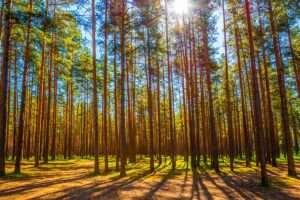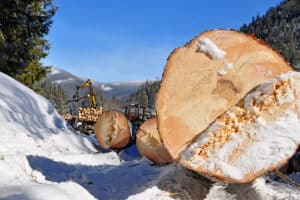Timberland sellers often provide buyers with an estimate of their property’s timber volume and its value. I’ve seen these take many forms: an oral opinion usually preceded by the phrase “at least”; a hand-scribbled scrap of paper that said “oak, $200,000, pine, $50,000” etc.; a walk-through estimate done by a consulting forester the seller hired; several hundred pages of consultant-gathered-and-analyzed data sliced and diced every which way; and aerial images that indicate volume and other specifics, among many others.
My experience over the years with seller timber estimates in all formats is that they always need to be verified, and, at worst, they are frauds. Of the seller-supplied estimates I’ve seen, I’d guess that at least half inflate the volume and/or value of the seller’s timber beyond what timber buyers would pay for. Inflation has ranged from a modest amount to, literally, $100 million, on a tract whose timber was without any commercial value owing to regulatory constraints.
I have also seen buyers work the same game with sellers by handing the seller a cruise that underestimates the seller’s timber resource and its current market value. Of the two, a bogus seller-supplied estimate is the far more common.
Different ways exist to estimate timber volume in the field, referred to as stumpage. A timber cruise can be done with various methods according to property specifics, but, generally speaking, the most common is a procedure that samples the property’s timber characteristics in a systematic way and then projects tract-wide totals to indicate volumes by species and size. The dollar value of each category (of species and size) is calculated by multiplying the aggregated volume by the current market price for that type of stumpage. The forester gathers current market prices from area timber buyers. These prices are expressed in units, such as $/board foot, $/ton, $/cord, or $/cubic yard. The forester derives a single price multiplier from this research and applies it against the aggregated volume for each species to get a current market value.
While cruises use different formats, 50 acres of mainly hardwoods might be presented in a very simplified form like this:
Timber Cruise for Mr. Johnson’s 50 acres
3 miles west of Tranquility in Peaceful County
July 21, 2009
Diameter classes, DBH (diameter at breast height, 4.5 feet above ground)
Doyle Scale 25 plots
45/50 acres cruised for merchantable volume
1000s bf
<12” 12-14 14-16 16-18 >18 Total $per Total value
Vol. 1000/bf
Red oak 5 5 5 10 300 $3,000
Sugar Maple 10 20 8 28 400 11,200
Chestnut oak 4 10 10 75 750
Black birch 15 10 20 200
Pine 15 10 15 30 55 50 2,750
Misc. HW 10 10 10 60 600
Veneer
Cherry 5 5 1,500 7,500
Pulpwood
HW 500 cords @ $7 cord 3,500
Pine 400 cords @ $6 cord 2,400
——- —– ———–
59 (premerch) 113 (merch)* $31,900
* Excludes 5,000 bf of veneer.
Volume summary:
Premerchantable volume, <12” D: 59,000 bf
Merchantable sawtimber, >12” D: 113,000 bf
HW veneer: 5,000 bf
Pulpwood, HW and Pine 900 cords
Sawlog volume per tract acre 113/50 = 2,260 bf/acre
Sawlog volume per cruised acre 113/45 = 2,511 bf/acre
Veneer per tract acre 5,000/50 = 100 bf/acre
Merchantable timber value = $31,900
Merchantable timber value per tract acre $31,900/50 = $638/acre
Premerchantable value estimated at $20/1000 bf = $1,180
Premerchantable value per tract acre $1,180/50 = $23.60
This cruise confines itself principally to merchantable sawtimber volume, which is stumpage that, simply put, is timber for which timber buyers will pay a sawlog price.
Timber volume that has no commercial value is not considered merchantable, even though there may be “a ton” of it on the property. Non-merchantable timber might include volume in small-diameter trees, or tree tops above, say, a 10”-inch diameter in the stem (that is, logs with big ends smaller than 10”) or trees that are located on inoperable acreage (which might be too steep or too wet to allow logging by local, conventional methods).
At 12” DBH in this market, timber buyers redefine trees for a different end product.
With stems smaller than 12” DBH, the uses are confined to relatively low-value end products such as ties, pulp, pellets or firewood. At 12” DBH and above, timber is reclassified as sawlog. Sawlog stumpage is much more valuable, because these larger logs can be milled efficiently into high-value end products, such as lumber and flooring. Veneer sawlogs are the most valued trees, and they fetch premium prices.
In this example, 12” DBH is the threshold between small-diameter timber used for low-value products and sawlogs. That threshold is referred to as the in-growth point. Above that point, the value of timber volume in all species increases substantially. I’ve seen in-growth thresholds as small as 10” and as large as 16”; it depends on local market conditions.
Some cruises will also estimate premerchantable volume (small-diameter trees) by species and diameter class so that projections can be made about when each premerch asset (say, red oak in the 8-10” cell) will achieve the threshold diameter of 12” and be reclassified as sawlog volume and fully valued at sawlog price. In this example, the forester put $20/1000 bf on the 59,000 bf of premerchantable volume. Premerchantable sawtimber represents future economic return much more than present value.
Each species grows at a different rate, and growth is also determined by the productivity of the site where the trees are growing. The timber-growing productivity of a particular spot is expressed as a site index–a number. In simple formulation, the higher the site index, the faster trees will grow. The county’s soil survey (available from the local office of the USDA’s Natural Resources and Conservation Service) maps all the soils in a county and provides site indices for each soil type and location.
The next several columns will discuss ways that cruises can be manipulated to increase (or in the much rarer case, decrease) merchantable timber volume and its value.
This content may not be used or reproduced in any manner whatsoever, in part or in whole, without written permission of LANDTHINK. Use of this content without permission is a violation of federal copyright law. The articles, posts, comments, opinions and information provided by LANDTHINK are for informational and research purposes only and DOES NOT substitute or coincide with the advice of an attorney, accountant, real estate broker or any other licensed real estate professional. LANDTHINK strongly advises visitors and readers to seek their own professional guidance and advice related to buying, investing in or selling real estate.









Hey Doc,
Thanks for the in depth article that can be shared with non-timber folks to help educate them about selling and buying rural timber property in Alabama. The value of timber, like land, is akin’ to an old farmer’s mule…it all depends on if he is going into the barn, or coming out of it …
Looking forward to part II